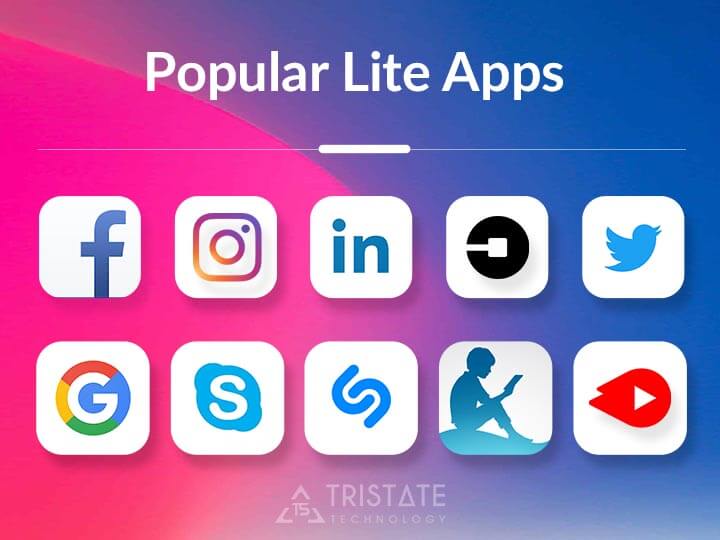
Nowadays, a mobile app becomes crucial for all industries, and it has revealed many business opportunities. Just imagine the existence of Facebook or Instagram without mobile apps. They couldn’t penetrate such huge market without mobile apps.
Oh! Wait. We cannot even imagine Uber without a mobile app. Can we? Nah.
These famous brands have covered an almost good part of the overall consumption in the developed countries. But, the rest of the world has two significant challenges, first is a slow internet connection and other is low-end devices. Then, WHAT IS THE SOLUTION?
What is the Lite version of the app?
To understand this, continue reading-
In the app stores, you may find two versions of some apps with “Lite” postfix having many downloads and even in a few cases, more popular than a normal application. Here is the list of few popular Lite apps:

And many others.
So, what does “Lite” mean? Why do brands even need them?
Lite app is a limited featured app mainly designed for low-end devices. Normal apps generally have app size about 40~50 MB whereas these Lite versions have about 1~4 MB. Sounds interesting? Presently, we are enjoying the fastest network on 4G or 3G and expecting a lightning-fast 5G network soon, but many countries in the world are still using a legacy network like 2G. But these Lite apps work great with such slow internet connections.
Facebook has developed a Lite version for the users of developing countries and acquired billion of users. Facebook’s Lite version works in an extremely slow 2G network with less than 1 MB installation space and limited access to internet data. In this Lite version, they trimmed some features which need a comparatively large amount of data and storage like nearby friends, videos, etc. Similarly, other famous apps have taken the same approach to penetrate the developing market.
So now, you have enough idea about the Lite app. Probably, you would have a question that “From an end-user point of view, how the Lite version will be different than a standard app?”
Just like you, many other end users have this question in their minds.
In general, a Lite app is different from the standard app for end users in terms of the following parameters:
- Size
- Battery usage
- App UI
- App speed
- Data usage
So, let’s dig deeper to know more about these parameters and find out what makes the Lite app different –
App size
Some app users prefer to uninstall the apps which they do not frequently use from their smartphones.
The intention is just to free up space in their phones to improve its performance and to make room for more important and relevant apps.
For businesses that have only official apps available to end-users, this simply means the loss of users.
To tackle this, they can come up with Lite apps, which are smaller versions of the main apps.
Lite apps are typically less than 1 MB in memory size. So, a user won’t generally feel the need to uninstall them.
Want to develop a lite version of your business app?
Battery usage
Even though everyone loves to use apps as per their preferences, no one likes to have their phone’s battery getting drained faster.
Standardized, official versions of apps are known to consume a lot of battery. This is because of their back-end functionalities that stay active all the time along with the front-end utilities given to the users.
Because of this, some users end up deleting the apps that seem to drain their phone’s battery.
Lite apps, on the other end, are designed with features that do not result in the faster battery draining.
Ultimately, the use of these lighter apps results in the end user retention.
App’s user interface
Except those who are tech-savvy, not every mobile app user knows that images, animations, videos, and similar other elements make an app heavier in size.
In some cases, Lite apps are designed to engage the end users and prompt them to use its original version.
Accordingly, these design elements have an impact on the app’s performance, size, and usage.
Lite apps are different from the standardized apps. They are designed with a minimalistic approach and have only lighter UI elements taken in use, not the heavier ones.
App speed
As detailed above, Lite apps are smaller in memory size and have a simple, clean interface. These features have their effect on improving the app’s performance and speed for the end users.
Data usage
Obviously, not all users have high-end smartphones. Neither Internet connectivity is great in all locations across the globe. This aspect also gets covered when designing Lite apps.
Along with the smaller memory size, Lite apps work well in regions with poor Internet connectivity and in all phones, whether they are 2G, 3G, or 4G compatible.
This means that Lite apps come into the reach of those who are not using the latest, tech-advanced smartphones.
Use lite apps to drive downloads for main mobile Apps
With all the details mentioned above, you now know well about the difference between the Lite apps and the official mobile apps of famous brands around the world. Also, the reasons why these popular brands develop Lite apps.
Are you looking to develop a Lite app to improve the user experience of your mobile app users? Let’s discuss the strategy and get you the growth you always wanted to have.




